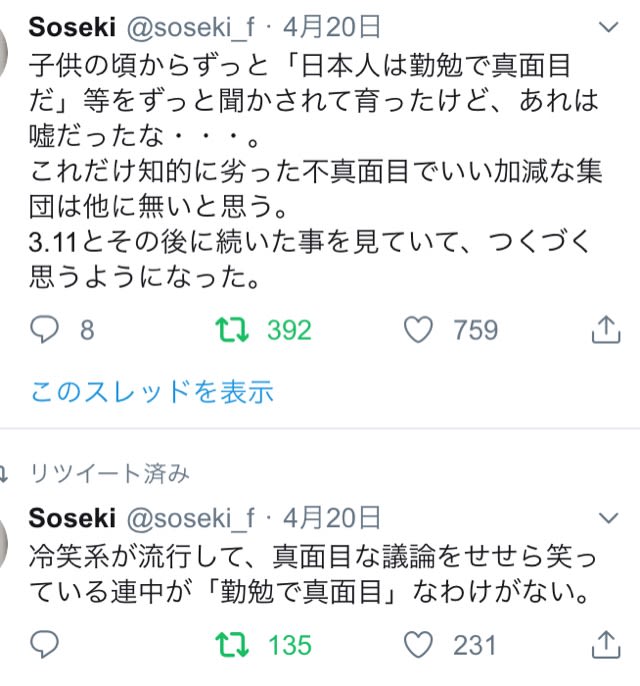内部被爆という研究分野はまだまだ息の長い研究が必要な分野なので
今ある食品中の線量基準値だけ問題にしても、それが科学的根拠とは「言えない」のでは?
という韓国側の考え方は至極真っ当ではとまとめていたのだけど、
そもそものWTOの報告書(結論)に触れていなかったので補足です。
6 FINDINGS AND CONCLUSIONS
のところの6.2に詳細があります。以下英文。
6.2. A panel examining a claim under Article 5.6 of the SPS Agreement is charged with, inter alia, ascertaining the respondent's ALOP on the basis of the totality of the arguments and evidence on the Panel record. A panel is also required to identify the level of protection that would be achieved by the alternative measure proposed by the complainant. The Panel in this dispute accepted Korea's own articulation of the relevant ALOP as one containing the following elements concerning radioactivity levels in food consumed by Korean consumers: (i) the levels that exist in the ordinary environment; (ii) exposure "as low as reasonably achievable"; and (iii) the quantitative dose exposure of 1 mSv/year. While the Panel accepted Korea's articulation of this multi-faceted ALOP, its analysis focuses on the quantitative element of 1 mSv/year. The Panel reached conclusions with respect to Japan's alternative measure that leave unclear whether it considered the alternative measure to satisfy all of the elements of Korea's ALOP it had identified. The Panel's findings effectively subordinated the elements of ALARA and radioactivity levels "in the ordinary environment" to the quantitative element of exposure below 1 mSv/year. This is at odds with the articulation of the ALOP explicitly accepted by the Panel at the outset of its analysis.
a. We therefore find that the Panel erred in its application
of Article 5.6 of the SPS Agreement
in finding that Japan's proposed alternative measure
achieves Korea's ALOP.
a. Consequently, we reverse the Panel's findings of
inconsistency with Article 5.6
with respect to:
(i) the adoption of the blanket import ban
(except for the ban on Pacific cod from Fukushima
and Ibaraki) and the 2013 additional testing
requirements; and (ii) the maintenance of all
of Korea's measures.
この紛争のパネルは、韓国の消費者が消費する食品中の放射能レベルに関する以下の要素を含むものとして、韓国自身の関連するALOPの明確化を認めた。
(i)通常の環境に存在するレベル。
(ii)「合理的に達成可能な限り低い」暴露。
*ALARA[as low as reasonably achievable]
(iii)1 mSv /年の定量的被ばく線量。
パネルはこの多面的なALOPの韓国の明確化を受け入れましたが、その分析は1 mSv /年の量的要素に焦点を当てています。
パネルは、識別した韓国のALOP(適切な衛生健康保護水準)のすべての要素を満たすための代替措置を検討したかどうかは不明のままであるという日本の代替措置に関して結論に達した。
パネルの調査結果は、「通常の環境における」ALARAと放射能レベルの要素を1 mSv /年以下の被ばくの定量的要素に効果的に置き換えた。これは、分析の開始時にパネルによって明示的に受け入れられているALOPの明確化と相反するものです。
a。 したがって、我々は、日本が提案した代替措置が韓国のALOPを達成しているとの認定において、パネルがSPS協定の第5.6条の適用に誤りを犯したと考える。
a。 その結果、我々は、パネルの以下の点に関する矛盾した第5.6条との矛盾についての見解を覆した。 (ii)韓国のあらゆる措置の維持。
*SPS協定・・衛生植物検疫措置の適用に関するWTOの協定
*ALARA・・詳細(コトバンク)
いちばんのポイントになった部分だけ抜きましたが、これをもって前回のパネルの認定にはミスがあったということ。
なので、日本側の申し出は却下いたしますという内容ですね。
(i)通常の環境に存在するレベル。
(ii)「合理的に達成可能な限り低い」暴露。
この2つについてを満たすための基準というのは、文のように「1 mSv /年以下の被ばくの定量的要素」とイコールではなく・・
横道にそれますが・・
では韓国も納得するような措置ができるかといえば、莫大な金額がかかるのでやめているわけですね・・凍土壁だって、石棺よりはゼネコンとしては予算をもらえるでしょうけど、事実上、凍らせられず地下水は漏れているわけで??なぜ石棺にしない??とか・・issueたくさんありすぎですね
横道戻る
それより何より、食品中の線量基準で安全性を主張することが内部被爆という食品から微量の摂取であるにかかわらず有機的に結びついて特定の器官に蓄積され、遅延性の発癌や最近は先天性心疾患の乳児増加など、やけどのように単純な外部被曝とは違う研究分野において十分な科学的根拠など積み上がっているとは、まだまだ言い難いことを誠実に理解すれば
日本の「すでに安全性は証明しきっているではないか」という物言いも、それを韓国だけ対象に訴えているプロセスも傲慢です。
日本がフクシマ事故後の食品輸出において、自前の近焦点で今だけ自分だけな主張をしても、世界から納得を得ることはないでしょう。













